
Pupin is a tiny lunar impact crater located in the eastern part of the Mare Imbrium. It was named after Serbian-American physicist Mihajlo Pupin. It lies to the southeast of the crater Timocharis, and was identified as Timocharis K prior to being renamed by the IAU. The mare near Pupin is otherwise devoid of significant impact craters, and is nearly featureless except for a faint dusting of ray material.

Beer is a relatively small lunar impact crater located on the Mare Imbrium, to the east of the crater Timocharis. It was named after German astronomer Wilhelm W. Beer. Just to the northwest is the matching twin Feuillée.

Bessarion is a lunar impact crater located near the southwest edge of Mare Imbrium. It is named after Greek scholar Bessarion. Some distance to the east is the crater T. Mayer. Bessarion is a bowl-shaped crater with a low central rise and a higher albedo than the maria, making it a brighter feature when the sun is overhead.
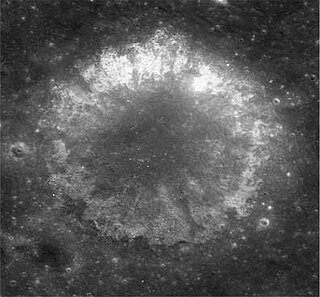
Sampson is a relatively tiny lunar impact crater located near the central part of the Mare Imbrium. It was named after British astronomer Ralph Allan Sampson. To the northeast is the crater Landsteiner and to the southeast lies Timocharis. East of this crater is the Dorsum Grabau, a wrinkle ridge in the mare.
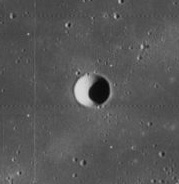
Zinner is a tiny lunar impact crater located due north of the crater Schiaparelli on the Oceanus Procellarum. It is circular and cup-shaped, with a high albedo in comparison to the surrounding lunar mare. The crater has essentially no rim because the mare lava nearly flooded it. A ray from the crater Glushko crosses Zinner. To the northwest is the slightly larger crater Golgi. East of Zinner is the Dorsa Burnet wrinkle ridge system.

Deseilligny is a small lunar impact crater in the southern part of the Mare Serenitatis. It was named after French selenographer Jules Deseilligny. It is located to the east-southeast of the crater Bessel. Deseilligny is a bowl-shaped crater with a low rim. It is otherwise undistinguished.
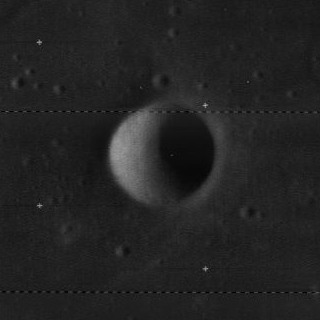
Lippershey is a relatively tiny lunar impact crater located in the southeast section of the Mare Nubium. It was named after German-Dutch optician Hans Lippershey. It is a circular, cup-shaped feature surrounded by the lunar mare. Lippershey lies to the northeast of the crater Pitatus.

Crile is a tiny lunar impact crater. It is roughly circular and cup-shaped, with interior walls that slope down to the midpoint. The crater lies in the Palus Somni, between the Mare Crisium to the east and Mare Tranquillitatis to the west.

Curtis is a very small lunar impact crater that lies in the western Mare Crisium, to the east of the crater Picard. It is a circular, cup-shaped formation that is otherwise undistinguished. It was named after American astronomer Heber D. Curtis in 1973. In the past it was designated Picard Z.

Timocharis is a prominent lunar impact crater located on the Mare Imbrium. It was named after ancient Greek astronomer Timocharis. The closest crater of comparable dimensions is Lambert to the west. The smaller craters Feuillée and Beer lie to the east of Timocharis.
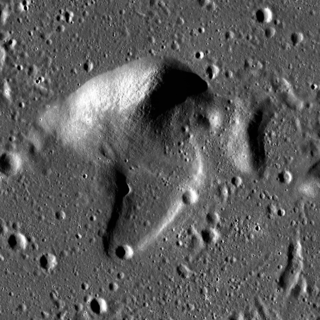
Fedorov is a lunar geologic feature located in the western Mare Imbrium named after Russian rocket scientist Aleksandr Petrovich Fedorov. It lies east-northeast of the crater Diophantus, and southeast of Delisle. About 20 kilometers to the south-southeast is the slightly larger formation of Artsimovich.
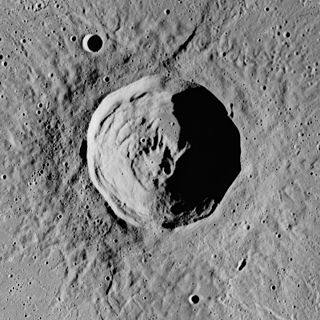
Lambert is a lunar impact crater on the southern half of the Mare Imbrium basin. It was named after Swiss polymath Johann Heinrich Lambert. It lies to the east and somewhat south of the slightly larger crater Timocharis. To the south is the smaller Pytheas, and some distance to the west-southwest is Euler.

Dollond is a small lunar impact crater that is located in the central region of the Moon, to the north of the crater Abulfeda. It was named after British optician John Dollond. Due west of Dollond is Anděl. Dollond is circular and cone shaped, with a tiny floor at the midpoint of the sloping interior walls.

Feuillée is a small lunar impact crater in the eastern part of the Mare Imbrium. It was named after French natural scientist Louis Feuillée. It lies less than a half crater diameter to the northwest of Beer, and the two formations form a nearly matched pair. To the west is the small but prominent crater Timocharis.

Elmer is a small lunar impact crater that is located to the south of Mare Smythii, near the eastern limb of the Moon. This crater is seen at a highly oblique angle from Earth, and the visibility is affected by libration. Elmer lies southwest of the crater Kreiken, and east-southeast of the larger Dale. This is a circular, bowl-shaped crater with an interior floor that occupies about half the total diameter.

Heinrich is a small lunar impact crater on the Mare Imbrium, a lunar mare in the northwest quadrant of the Moon's near side. It was named after Czechoslovakian astronomer Wladimir Wáclav Heinrich. It is a circular, bowl-shaped formation very similar to many other craters of comparable size on the Moon.

Focas is a small lunar impact crater that lies on the far side of the Moon, just past the southwestern limb. In this location the crater is occasionally brought into view due to libration, but not much detail can be seen because the crater is viewed from the side.

Bliss is small lunar impact crater that is located just to the west of the dark-floored crater Plato. It lies in a region of continental terrain between Mare Imbrium to the south and Mare Frigoris to the north. This crater is bowl-shaped, with a small interior floor at the midpoint and a somewhat eroded outer rim.

Carnot is a large crater in the northern part of the Moon's far side. It was named after Nicolas L. S. Carnot by the IAU in 1970.

Diderot is a small lunar impact crater on the far side of the Moon. It lies within the southwestern interior floor of the huge walled plain Fermi, about midway between the basin midpoint and the southwest rim. The crater is saucer-shaped, with smaller craters located just to the northwest and the north. The inner wall is narrower along the eastern side, and has a pair of ridges along the southern face. This crater is otherwise unremarkable.




















